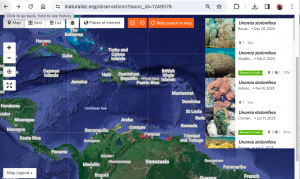
Unomia solonifera. Source: Comité Científico FVAS on iNaturalist
As if Stony Coral Tissue Loss Disease which took off in Barbados in 2023, followed by widespread coral bleaching associated with extreme warming weren’t enough to challenge our reefs, now marine biologists in the Caribbean are on the lookout for an invasive soft coral originating from the Indo-Pacific.
It is Unomia stolonifera, commonly known as “stoloniferous fire coral”. It will grow over any hard substrate. Currently, it is socked in on reefs and seagrass beds on the northeastern coast of Venezuela, Southeastern Caribbean Sea. It is believed that Unomia stolonifera was introduced via the aquarium trade in the early 2000s. It was first sighted in Venezuela at Valle Seco in 2007. Subsequently “the population has exploded along Venezuela’s coastline and has now been observed spreading east and west into the Caribbean Sea.” (icriforum.org, June 12, 2023)
More from icriforum.org on why we need to be concerned:
Due to the high fecundity, rapid growth, and absence of natural predators, U. stolonifera has proliferated vast expanses of coral reefs. This rapid colonisation has had detrimental impacts on the biodiversity of the affected ecosystems, growing over any hard substrate, including corals and seagrass. In areas most heavily impacted, the invasive soft coral now accounts for 100% of coral cover, eradicating a diverse array of native species. Ongoing research indicates that among the severely affected taxa are coral reef fishes, whose populations have suffered significant declines impacting both ecosystem function and services relied upon by many stakeholders.
To date, it appears that the only invasive marine species of concern in Barbados has been Lionfish. So far, according to a recent report* it has proved manageable. It sounds like stoloniferous fire coral could be much more challenging. I suggest reporting any suspected sightings of stoloniferous fire coral to the Barbados Ministry of Environment and National Beautification.
_________
*Vallès, H., J. Walcott and H.A. Oxenford. 2023. Assessment and Management of Lionfish and Status of Other Marine Invasive Species of Threat to High Biodiversity-value Reef Ecosystems. Draft Final Report. Preventing Costs of Invasive Alien Species (IAS) in Barbados and Countries of the OECS Project. CERMES, UWI, Cave Hill, Barbados, 53pp.
More info, photos

Unomia stolonifera on iNaturalist. The only confirmed reports within the Caribbean are from the coast of Venezuela. There is currently a report, not currently confirmed, of specimens at Bocas de caldera, Havana, Cuba (observation on Dec 29, 2023)
Post on icriforum.org, June 12, 2023
Deadly invader devastating Venezuelan coral reefs
by Margioni BERMÚDEZ on phys.org, Aug 27, 2023
The invasive octocoral Unomia stolonifera (Alcyonacea, Xeniidae) is dominating the benthos in the Southeastern Caribbean Sea
Ruiz-Allais et cl. 2021 publishedin Memoria de la Fundación La Salle de Ciencias Naturale Vol. 79 Núm. 187.
